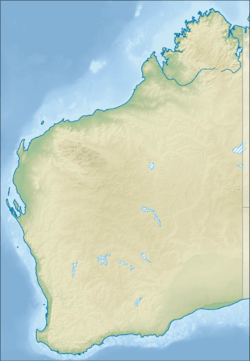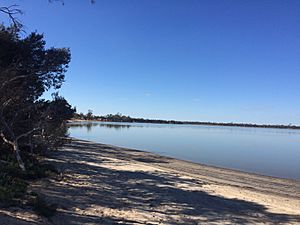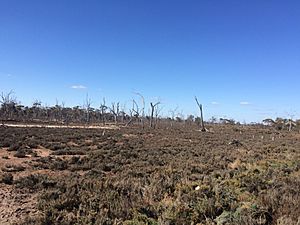Lake Ewlyamartup facts for kids
Quick facts for kids Lake Ewlyamartup |
|
|---|---|

Lake Ewlyamartup 2018
|
|
| Location | Great Southern, Western Australia |
| Coordinates | 33°41′36″S 117°44′25″E / 33.69333°S 117.74028°E |
| Type | Saline |
| Primary inflows | Groundwater and surface runoff |
| Catchment area | 50,700 ha (125,000 acres) |
| Basin countries | Australia |
| Surface area | 88 to 100 ha (220 to 250 acres) |
Lake Ewlyamartup is a special kind of lake in Western Australia. It's called an ephemeral salt lake. This means it's a lake that sometimes dries up and its water is salty. It is found in the Great Southern area. The lake is about 17 km (11 mi) (11 miles) east of a town called Katanning. It is also about 294 km (183 mi) (183 miles) southeast of Perth.
Contents
About Lake Ewlyamartup
The land around Lake Ewlyamartup is called its catchment area. This area is very large, covering 50,700 ha (125,000 acres). It gets about 478 mm (18.8 in) of rain each year. However, much more water evaporates, about 1,826 mm (71.9 in) per year.
The landscape here has both salty and fresh lakes and swamps. There are also sand dunes and hills. The lake itself sits on old natural water paths.
Long ago, Lake Ewlyamartup was a source of fresh water. But people cleared a lot of land around it. This caused the lake to become salty. By 2010, the water was three times saltier than the ocean!
Water flows into the lake from Ewlyamartup Creek. This creek is at the northern end of the lake. In very wet years, the lake can overflow. When this happens, the water flows west from the creek. It then goes into the Coblinine River.
History of the Lake
The original owners of this land are the Noongar people. Specifically, it was the Koreng group. The name Ewlyamartup means "come now to this place where there is a water hole associated with a leg."
A special sacred site is located near the lake. Hundreds of years ago, it was a camp for Indigenous people. The lake provided fresh water for them. The Noongar people would fish and hunt kangaroos in the area.
In 1835, two explorers named James Stirling and John Septimus Roe visited the area. They were traveling from Perth to Albany. Later, in 1870, people came to cut sandalwood trees. By 1889, settlers arrived to start farms.
Most of the natural plants in the catchment area were cleared for farming. Now, only about 9% of the original plants remain.
In 1912, a dam was built near the lake. It was dug out of the ground. The dam was meant to hold a lot of water, but there wasn't much water in the lake to fill it.
Lake Ewlyamartup has water flowing in, but no water flowing out. This means mud and dirt can build up in the lake. In 2010, the local community worked together. They removed 20,000 m3 (710,000 cu ft) of nutrient-rich mud from the lake. They also planted 100,000 trees in the surrounding area. Since then, another 150,000 trees have been planted!
The lake is a popular spot for fun activities. People enjoy bird watching and camping there. When the water levels are high enough, you can go canoeing, kayaking, sailing, swimming, water-skiing, and windsurfing.
There are many facilities at the lake for visitors. These include a parking area, picnic tables, and shelters. You can also find barbecues, toilets, a boat ramp, and a bird hide. There are also areas for camping.
Plants Around the Lake
The area around Lake Ewlyamartup is part of the Dumbleyung Vegetation System. This system has gently rolling hills. There are also flat, salty areas and lakes in the larger valleys.
The plant life includes open woodlands with trees like york gum, red morrell, salmon gum, and wandoo. In the salty areas, you can find smaller trees called mallees, teatree, and samphire plants.
Other plants growing near the lake's edges include Eucalyptus occidentalis, Eucalyptus spathulata, Allocasuarina huegeliana, Casuarina obesa, Banksia prionotes, Melaleuca pritzelii, and Verticordia huegelii var. tridens.
Animals Living Near the Lake
Many different animals live around Lake Ewlyamartup. There are 8 types of frogs, 42 types of reptiles, and 26 types of mammals.
The lake is especially rich in bird life. A total of 95 different bird species have been seen around the lake. This includes the endangered hooded plover and the freckled duck.
Other birds you might spot at the lake are the chestnut teal, banded stilt, common sandpiper, red-necked avocet, red-kneed dotterel, common greenshank, wood sandpiper, and black-winged stilt.




